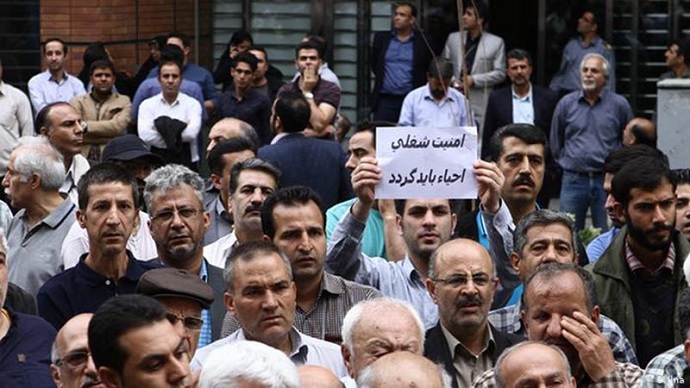On March 19, on the last day of the Persian year 1402, Iran’s regime announced the minimum wage and basic salary for workers for the year 1403. With this announcement, poverty and destitution once again cast a shadow over millions of workers’ families, making their holiday and New Year celebrations gloomy and dark.
It is a well-known tactic of the regime to postpone the determination of the minimum wage to the last day of the year and the Nowruz holidays to deprive workers of any opportunity for protest. Last year as well, the minimum wage was announced at 3 a.m. on March 20, 2023.
On March 19, the official IRNA News Agency wrote, “The announced figure indicates a 35% increase in the base salary and only a 22% increase in salaries for other levels.”
This is even though the regime’s Central Bank has stated an inflation rate of 43%, though the real figure is much higher. Some elements and media outlets of the regime report three-digit inflation rates, especially in food items.
On March 11, the state-run Setareh Sobh newspaper quoted the Statics Center of Iran as saying, “The prices of fruits and vegetables have increased by 100% to 200% in the past two years, and the prices of white and red meat have also become more than four times higher compared to the summer of 2021.
The widening gap between wages and salaries, inflation rates, and increasing prices is a recurring tragedy that has been happening for several years. As a result, the lives of workers and hardworking people have become darker each year compared to the previous year, and they are increasingly plunged into poverty and deprivation.
The announcement of the minimum wage for workers this year, like previous years, was accompanied by deception. Initially, Minister of Labor Sowlat Mortazavi declared a 22% increase in wages, which sparked protests by those who claim to represent the workers themselves.
In this regard, the head of the Supreme Center of Labor Unions of the country, Samia Golpour, in an interview with the state-run Khabar Online news website, said that even if workers’ wages were increased “not by 100%, but by 300%, it still wouldn’t reach the poverty line,” but then somehow reached the conclusion that the minimum wage should be increased by more than 35%.
Eventually, this figure was announced without the presence of the so-called labor representatives, who had left the Supreme Labor Council session as a form of protest, to avoid the trouble of responding to the workers.
The announcement of a wage that doesn’t even reach one-third of the poverty line is not only in conflict with international laws and standards but also contradicts the regime’s own enacted laws. According to Articles 41 and 42 of the Labor Law, the Supreme Labor Council is obliged to determine the minimum wage for different regions of the country and industries based on the inflation rate.
The minimum wage is determined based on a table that encompasses all the consumption needs of a working-class family, including food, clothing, hygiene products, healthcare, housing, and other living expenses. It is calculated based on the average number of members in a working-class family, which the regime has set at 3.3 individuals. However, it has been years since this table has been neglected and forgotten in the regime, without any attention or updates.
In 2024, to create a pretext for justifying the poverty and deprivation of workers, the regime, in a disgraceful and shameful act, introduced two tables solely for food items through its Ministry of Health. One is titled “Desirable Food Basket for the Iranian Society,” and the other is titled “Affordable Food Basket.”
The number of food items on both tables is the same, consisting of 13 items. However, in both tables, the per capita consumption of bread, rice, fruits, red meat, white meat, and sugar has decreased compared to the basket proposed in 2013. Furthermore, in the “affordable” basket, there have been significant reductions in the weight of daily required quantities for these items. Not only items like meat and rice, but even the amount of bread consumed (30 grams per person) has decreased in this basket, which is obviously intended for workers. While this document has been referenced in the meetings of the Minimum Wage Committee of the Supreme Labor Council, the regime’s Ministry of Health deceitfully claims that the determined food basket is for the general population and has no impact on determining workers’ wages.
This only relates to food items. As for housing expenses, which on average consume 70% of workers’ and laborers’ salaries, the situation is even more disastrous. Workers are forced to move from the urban centers towards the outskirts of poverty-stricken areas that have expanded around all cities.
In this manner, workers of Iran have come to realize that in a corrupt and exploitative dictatorship of the ruling regime, there is no future or prospect other than gradual destruction for themselves and their children. Every day, they become more convinced of the reality that the only way forward, in the face of absolute suffocation where organizing and forming labor unions is impossible, is to connect with organized resistance and join or support Resistance Units to break free from the clutches of this wicked regime.





